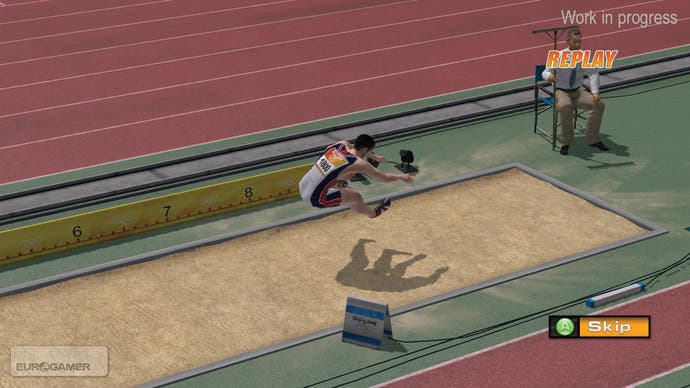Beijing 2008
Olymping over the finishing line.
Some of us never tired of button-bashing with a bit of precision timing thrown in. Ever since Konami introduced the concept 25 years ago, I've been there, abusing my carpal tunnels to defeat improbable high scores. It's a curious addiction, and one faithfully re-enabled by SEGA and Eurocom's take on sport's age-old sub-genre. Timed to officially cash in on the impending arrival of the 2008 Beijing Olympics, SEGA's game is exhaustive. You take your pick of 38 sporting disciplines including track, field, aquatics, gymnastics, shooting, weightlifting, cycling, kayaking, judo and table tennis [and copying lists off the press release - Ed], and you can set up your own competition and play offline against up to three friends or online in a group of eight.
On the whole, Eurocom's take on the events occupies a logical middle-ground between Konami's button-mashing Track & Field/Hyper Sports approach and the considered, timing-based system favoured by Epyx's timeless mid-'80s classics Summer Games II and Winter Games. Beijing 2008 doesn't always throw out old-fashioned mechanics for the sake of it, however simple they may be, and at least a portion of the events remind us how much fun it is to look like a frothing lunatic in pursuit of computerised athletic glory.
Initial impressions are reasonably favourable. The presentation is slick, with a clean, uncluttered front-end, decent motion-capture and excellent facial detail. It's easy to get into whichever event you want, and intuitive to get a multiplayer competition going to your precise requirements - just as it should be. It's only when you have to press the 'skip' button four times to get beyond the drawn-out intro sequences that you start to arch a quizzical eyebrow.

Later on, you face the full force of ruinous new ideas. Take the track or swimming race events, for example. Eurocom asks players to build up a pre-race power meter while they're positioned on the blocks by pressing either of the shoulder buttons, and then do the usual mashing. Unfortunately, power builds up too quickly, meaning you have to work very hard not to false-start. Correctly gauging the precise time to press the shoulder button in advance of the pistol shot is almost impossible, and in reality, you'll almost always find yourself leaving the blocks late and playing catch-up. The 800m and 1500m where you start without the blocks bit are a lot more fun.
On the other extreme, familiar field events are handled with the minimum of interference and show off Beijing 2008 at its most enjoyable. Events like long-jump, triple-jump and javelin work well, allowing players to get on with building power, setting themselves and going for the good old 45-degree sweet-spot. On occasion, some of the events, such as high-jump and pole-vault, actually improve on any previous implementation by adding mechanics that work brilliantly in the context of the sport, demanding players button-match, Quick Time Event-style, and get the timing spot-on to determine the quality of the jump. Elsewhere, the initially-tricky shot-put, discus and hammer-throw introduce players to rotating either analogue-stick to gauge accuracy or 'wind up' power - a mechanic that works its way into numerous other events elsewhere.

But as is inevitable with so many events, the mechanics don't always translate or just aren't implemented in a satisfyingly playable way. The diving events, for instance, show your athlete spinning around in slow-motion towards the pool, and in order to pull off the moves with high-scoring precision you must align and rotate your cursor at the designated point. It's a frustrating mess, and getting a decent score relies more on blind luck than anything.


